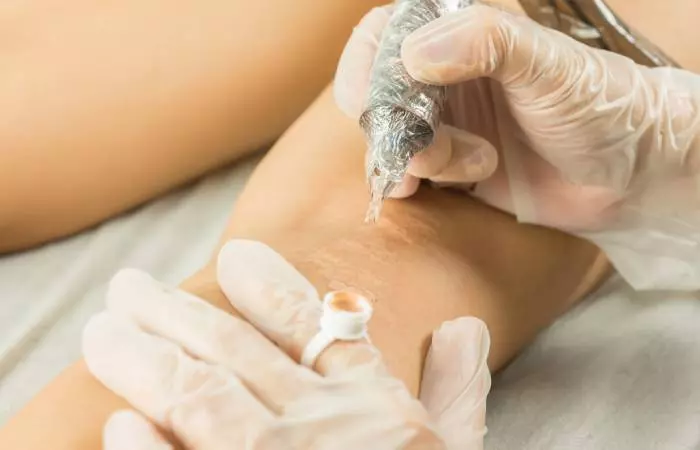
Scars from surgeries, injuries, or trauma can be a lasting reminder of painful experiences from the past. While many people wear them with pride, some may want to hide them. So if you’re wondering, “Can you tattoo over scars?”, you’ve come to the right place. Tattooing over scars is a creative and powerful way to reclaim your body and transform scars into meaningful works of art. Tattoo artists expertly navigate through scar tissue to create designs that seamlessly blend with these marks and achieve the desired aesthetic result. While tattooing over scars doesn’t erase the past, it does offer a unique opportunity for self-expression that allows individuals to transform their scars into personal symbols of beauty. Want to learn more about this process? Read on!
Can you tattoo over scars?
 Image: Shutterstock
Image: Shutterstock
Tattooing over scarred skin is possible, but it can be challenging. That’s why it’s important to find a licensed tattoo artist who has experience working with scars. Experienced tattoo artists can adapt their techniques to the changing texture and composition of scar tissue. While the process doesn’t eliminate scars, it does allow individuals to transform them into works of art and expression. The success of tattooing over scars depends on the type of scar, age, and skin condition.

When choosing a design, keep in mind whether you want to cover up or emphasize the scar. Consult with an experienced tattoo artist to avoid smudging or fading the tattoo.
While it is possible to cover your scars with tattoos, does it hurt as much as getting a tattoo on unbroken skin? Find out in the next section.
Does it hurt to tattoo a scar?
 Image: Shutterstock
Image: Shutterstock
Tattooing over scars can be more uncomfortable than tattooing over undamaged skin because scar tissue can be more sensitive. Scars lack the same elasticity as undamaged skin, and exposed nerve endings can contribute to increased discomfort. Scar tissue also does not absorb ink as easily, requiring multiple sessions with a skilled artist to achieve the desired result. Pain tolerance varies from person to person, but people who tattoo over scars often report increased sensitivity or no sensitivity at all. However, numbing agents and skilled tattoo artists can help manage the discomfort.
While an individual’s pain threshold is an important factor, the type of scar also determines whether or not a tattoo is possible. See the next section for more information.
Types of scars
Scars are the result of the skin’s healing process after injury or surgery. Each type of scar has its own appearance and texture. Understanding these differences is crucial for effective scar management and possible aesthetic considerations, such as tattooing over scars.
Keloids are raised, thickened scars that form after a wound has healed. Tattooing over keloid scars presents unique challenges due to their distinctive characteristics and they often extend beyond the original wound site. Consulting with an experienced tattoo artist and a health care professional is crucial. A careful evaluation of the specific characteristics of the keloid and the individual’s skin type will help determine the feasibility and potential risks of getting a tattoo.
Hypertrophic scars are raised, red scars that remain within the boundaries of the wound. While it is possible to tattoo over your hypertrophic scars, it is important to wait 1-3 years before getting them tattooed. Hypertrophic scars may respond better to tattooing than keloids. However, the process requires expertise to navigate the altered texture and color of the scar tissue.
Atrophic scars are indented scars that develop under the new layer of skin. Tattooing over this type of scar is possible and is considered safer than any other type of scar. However, the thinner and discolored skin requires that one find a tattoo design that enhances the natural contours rather than masking them.
Contracture scars develop after second or third degree burns and result in tightening of the skin. The altered texture and fragility of the skin can pose challenges to successful tattooing. Using different colorful tattoo inks and lines can help to hide these types of scars. However, be careful during the process as the integrity of the skin is compromised. Therefore, consult a health care provider before tattooing.
You can easily tattoo over your stretch marks. However, consider the sensitivity of stretch mark skin before getting a tattoo. Tattooing over a healed stretch mark doesn’t hurt much, but tattooing over a new stretch mark can be more painful and itchy. Therefore, consult a medical professional and a licensed tattoo artist who is experienced in tattooing over scar tissue.
The type of scar determines how long you should wait before tattooing over your scar. Scroll down to the next section for more information.
How long should I wait to get a tattoo over a scar?
 Image: Shutterstock
Image: Shutterstock
Avoid getting a tattoo on fresh scars and wait until they have fully healed. While some scars take at least a year to heal properly, others can take 3-5 years. Waiting allows the scar tissue to mature and settle, reducing the risk of complications during tattooing. Consult with an experienced tattoo artist and your healthcare provider to assess the condition of your scar before getting a tattoo.
The following factors influence the waiting time before a tattoo is applied to the scar:
Scar size and depth: Larger or deeper scars may take longer to heal and stabilize. The extent of tissue damage also affects the healing process. Location of the scar: The location of the scar on your body can affect healing. Areas with more movement or tension may take longer for the scar to settle. Individual factors: A person’s overall health, immune system, and genes can affect the speed and quality of scar healing.
You can use silicone-based gels or sheets to promote healing and help the ink hold better after the tattoo.
It is wise to seek professional medical advice before going under the needle to cover your scar with a tattoo.
Tattooing over your scars is a personal and meaningful decision. It requires careful consideration, patience, and collaboration with skilled professionals who understand the complexities of scar tissue. Transforming scars into works of art symbolizes resilience and self-expression, allowing you to reclaim ownership of your body. As you navigate this process, remember that scar type, depth, and location will determine the healing process before you get tattooed. So get started and embark on a path that transforms your scars and allows you to confidently express your identity.
Frequently Asked Questions
Can you get a tattoo over self-harm scars?
Yes, tattooing over self-harm scars is possible. Choosing bold designs over minimalist ones helps to hide your scars and offers a creative avenue for personal expression and transformation.
Which tattoos are best suited for covering scars?
You can use almost any tattoo style to cover a scar, but realistic tattoos are the best option because they can camouflage the scar better than most one-dimensional designs. They can effectively hide and blend in with your skin texture, creating a visually appealing result.
Are there specific aftercare instructions for tattoos on scars?
Just make sure you follow your artist’s aftercare instructions closely. If you notice any discomfort, irritation or other issues, let them know or consult a doctor if necessary.
Can scar tissue affect the vibrancy or clarity of the tattoo design?
Yes, the altered texture and composition of the scar tissue can affect ink absorption, potentially resulting in variations in color and sharpness. You may need to have touch-ups several times a week to maintain the vibrancy and clarity of the tattoo.
Key Points
Consider the size, age, location, and texture of the scar before getting a tattoo over a scar. The sensitivity of scar tissue can make tattooing over scars more uncomfortable and may require numbing agents and an experienced tattoo artist. It is recommended to wait a year or two before getting a tattoo over a scar for best results.
Image: Stable Diffusion/StyleCraze Design Team
Getting a tattoo over your scar is a big decision and requires careful consideration. Watch this video to learn more about the procedure and how it can affect your scar.
Personal experience: Source
StyleCraze’s articles are interwoven with authentic personal stories that add depth and resonance to our content. Below are the sources of the personal accounts referenced in this article.
(i). I got a tattoo to cover my stretch marks, now I’m getting them lasered off! https://www.youtube.com/watch?v=zkkGOhvxbeUWDid you find this article helpful? ReviewerAuthorEditorFact Check
![]() Scott Terry is a renowned tattoo artist with over 20 years of experience in the field. He specializes in color and black and gray realism. Scott graduated from the Joe Blasco School of Professional Makeup Artistry.
Scott Terry is a renowned tattoo artist with over 20 years of experience in the field. He specializes in color and black and gray realism. Scott graduated from the Joe Blasco School of Professional Makeup Artistry.
Read Scott Terry’s full biography
![]() Shreya is a beauty and lifestyle writer with two years of experience. After graduating from Christ University, Bengaluru, she started as an intern writer for a non-profit organization, Bhumi. After that, she wrote for a progressive content website.
Shreya is a beauty and lifestyle writer with two years of experience. After graduating from Christ University, Bengaluru, she started as an intern writer for a non-profit organization, Bhumi. After that, she wrote for a progressive content website.
Read Shreya Mukherjee’s full biography
![]() Eshna is an associate editor and certified skin care coach. She has over three years of experience, a triple major bachelor’s degree in psychology, English and journalism from Mount Carmel College, Bengaluru, and a master’s degree in psychology from Sampurna Montfort College, Bengaluru.
Eshna is an associate editor and certified skin care coach. She has over three years of experience, a triple major bachelor’s degree in psychology, English and journalism from Mount Carmel College, Bengaluru, and a master’s degree in psychology from Sampurna Montfort College, Bengaluru.
Read the full biography of Eshna Das
![]() Gazala Ansari is a beauty and lifestyle writer with two years of experience. She writes on relationships, makeup and lifestyle and holds a Bachelor’s and Master’s degree in English Literature from Central University of Jharkhand.
Gazala Ansari is a beauty and lifestyle writer with two years of experience. She writes on relationships, makeup and lifestyle and holds a Bachelor’s and Master’s degree in English Literature from Central University of Jharkhand.
Read the full biography of Gazala Firdos Ansari
Leave a Reply